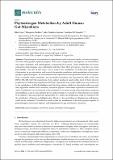Por favor, use este identificador para citar o enlazar a este item:
http://hdl.handle.net/10261/290168COMPARTIR / EXPORTAR:
 SHARE SHARE
 CORE
BASE CORE
BASE
|
|
| Visualizar otros formatos: MARC | Dublin Core | RDF | ORE | MODS | METS | DIDL | DATACITE | |

| Título: | Phytoestrogen metabolism by adult human gut microbiota |
Autor: | Gaya Sicilia, María Pilar; Medina, Milagros CSIC ORCID; Sánchez-Jiménez, A.; Landete, José María CSIC ORCID | Palabras clave: | Phytoestrogens Microbiota Equol Urolithins Enterolignans |
Fecha de publicación: | 2016 | Editor: | Multidisciplinary Digital Publishing Institute | Citación: | Molecules 21(8): e1034 (2016) | Resumen: | Phytoestrogens are plant-derived polyphenols with a structure similar to human estrogens. The three main groups of phytoestrogens, isoflavones, ellagitannins, and lignans, are transformed into equol, urolithins, and enterolignans, respectively, by bacteria. These metabolites have more estrogenic/antiestrogenic and antioxidant activities than their precursors, and they are more bioavailable. The aim of this study was to analyze the metabolism of isoflavones, lignans and ellagitannins by gut microbiota, and to study the possible correlation in the metabolism of these three groups of phytoestrogens. In vitro fermentation experiments were performed with feces samples from 14 healthy adult volunteers, and metabolite formation was measured by HPLC-PAD and HPLC-ESI/MS. Only the microbiota of one subject produced equol, while most of them showed production of O-desmethylangolensin (O-DMA). Significant inter-subject differences were observed in the metabolism of dihydrodaidzein and dihydrogenistein, while the glucoside isoflavones and their aglycones showed less variability, except for glycitin. Most subjects produced urolithins M-5 and E. Urolithin D was not detected, while uroltithin B was found in half of the individuals analyzed, and urolithins A and C were detected in two and four subjects, respectively. Enterolactone was found in all subjects, while enterodiol only appeared in five. Isoflavone metabolism could be correlated with the metabolism of lignans and ellagitannins. However, the metabolism of ellagitannins and lignans could not be correlated. This the first study where the metabolism of the three groups together of phytoestrogen, isoflavones, lignans, and ellagitannins by gut microbiota is analyzed. © 2016 by the authors; licensee MDPI. | URI: | http://hdl.handle.net/10261/290168 | DOI: | 10.3390/molecules21081034 | E-ISSN: | 1420-3049 |
| Aparece en las colecciones: | (INIA) Artículos |
Ficheros en este ítem:
| Fichero | Descripción | Tamaño | Formato | |
|---|---|---|---|---|
| 436.pdf | 859,85 kB | Adobe PDF |  Visualizar/Abrir |
CORE Recommender
PubMed Central
Citations
39
checked on 10-may-2024
SCOPUSTM
Citations
107
checked on 09-may-2024
WEB OF SCIENCETM
Citations
90
checked on 24-feb-2024
Page view(s)
30
checked on 15-may-2024
Download(s)
17
checked on 15-may-2024

